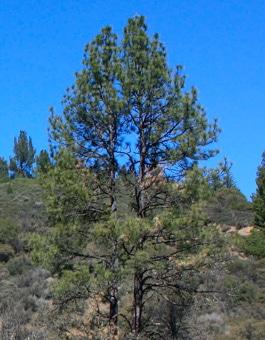

Born of fire
Unlike other closed-cone species whose cones open with hot weather, the knobcone pine must have fire for reproduction. Cones are sealed with a hard resin that requires high temperatures in excess of 350°F to open. An unburned knobcone pine cone will remain closed even after its host tree has decayed and fallen; it can stay viable for up to 50 years.
Range
The knobcone pine can be found on dry, rocky slopes and ridges of the coastal mountain ranges of southern Oregon to Baja California. It usually grows at altitudes of 2,600 to 4,500 feet and in fire-prone environments.
Character
Knobcone pines are tough trees, often growing in the poorest soils, so mature trees vary greatly in size from 25 to 75 feet tall depending on soils and other conditions. The cones are what make knobcones stand out - cones range from 3 to 5 inches long with a prominent knob on each scale. The bark is smooth, flaky and gray-brown when young, becoming dark gray-red-brown and shallowly furrowed into flat scaly ridges. The needles grow in bundles of three and are 3 to 7 inches long.
Understory
Its understory is typically herbaceous species and usually fire-followers. Along its range you’ll find a diverse understory of grasses, shrubs and cacti.
Climate
The knobcone pine grows best in climates characterized by wet, mild winters and hot, dry summers.
Management
Knobcone pine is used primarily for firewood. It is a small, shrubby tree that often has multiple tops, not making it desirable for many commercial products. Without fire present, most knobcone pine forests will eventually be replaced by tree species that are more tolerant of shade.